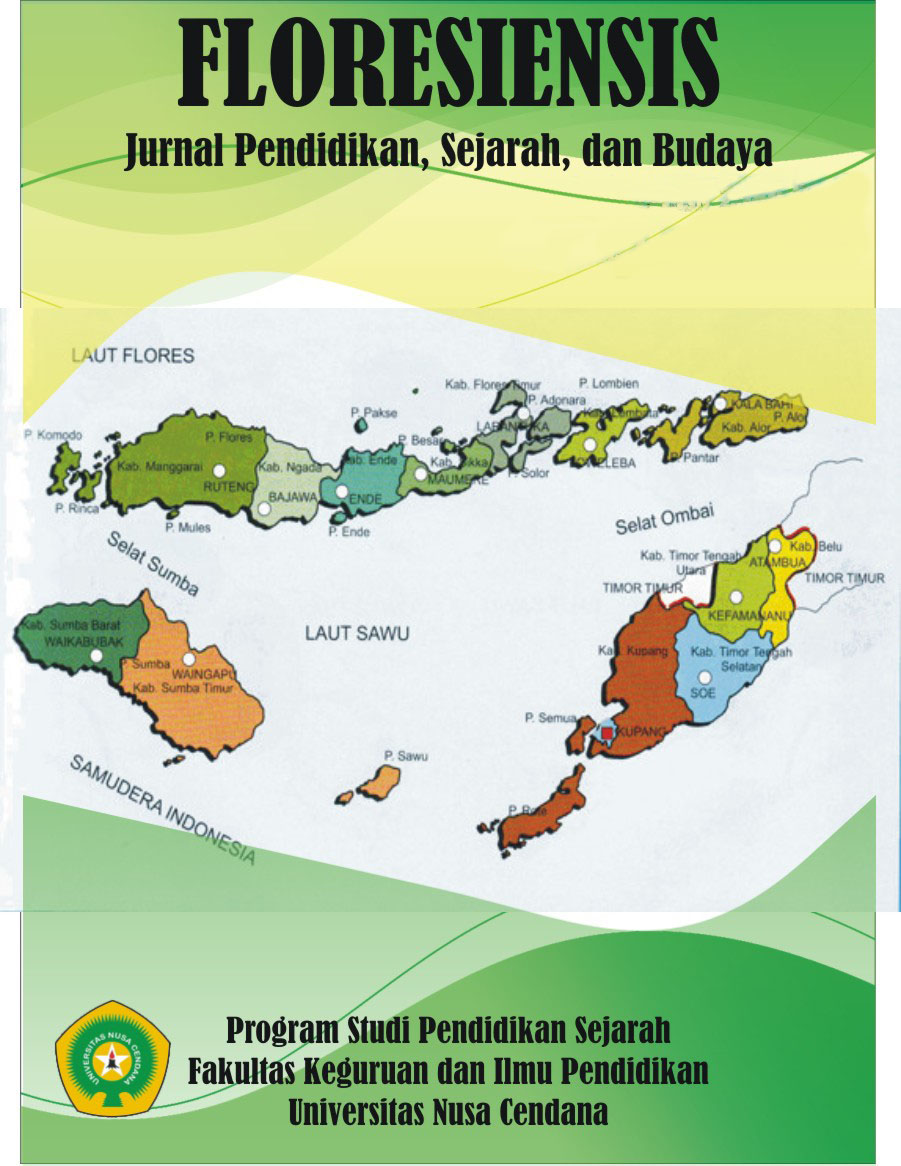Sejarah Museum Seribu Moko di Kabupaten Alor Tahun 2003-2023
Abstract
This research aims to find out The History of the Thousand Moko Museum in Alor District and to find out what collections are in the Thousand Moko Museum and the number of Moko stored in the Thousand Moko Museum. The type of research used is historical research. Informans in this research were determined using purposive sampling technique. The location of this research was in Kalabahi city, Teluk Mutiara Sub-district, Alor District. To obtain data in this research primary data sources and secondary data sources are needed. Data collection techniques are interviews, observation, and document study. The data analysis techniques used are heuristic, verification, interpretation, and historiography. The results of this research show that: (1) The Seribu Moko Museum was founded in 2003 and inaugurated in 2004. The name “Seribu Moko”, describes abundance, variety and hope, while “Moko”, describes traditional objects that are used by almost everyone. Layers of Alor society. The Seribu Moko Museum is under the Alor Regency Regional Government, in this case under the Culture Service. In managing this museum, because it is part of the Regional Government, there is number of budgets specifically for museum management. The development of the Seribu Moko Museum has experienced quite a lot of development. The Seribu Moko (Ct)um is still trying to make developments in order to attract the interest of visitors so that they feel comfortable when looking for information about cultural objects in the museum. (2) Moko is cultural object made of bronze which is shaped like a closed cormorant. Some theories say that Moko comes from the Dongson Culture in North Vietnam, while the Aloe people themselves believe that Moko comes from the land. Moko, which is highly valued by the people of Alor, has various shapes and decorations and some symbolize certain tribes. There are various types of cultural object collections in the Seribu Moko Museum, such as Moko, Archaeological, Numismatics, Biological, Ethnographic, Philological, Technological, Fine Arts, Ceramics, Geological, And Historical Collections.
Keywords: History, Museum, Moko, Development
Downloads
References
Bachtiar, Harsya W., Mattulada,.Haryati Soebadio. 1985. Budaya dan Manusia Indonesia. Yogyakarta: Hanindita
Gede, I Dewa Kompiang. 2013. “Misba dalam Masyarakat Alor: Kajian Bentuk dan Fungsi”. Forum Arkeologi 26 (3): 181-194.
Kistanto, Nurdien H. 2008. “Sistem Sosial-Budaya di Indonesia”, Sabda-Jurnal Kajian Kebudayaan, Volume 3, Nomor 1, April 99-105.
Koentjaraningrat. 1974. 1984a. Kebudayaan, Mentalitas dan Pembangunan. Jakarta: Gramedia.
Koentjaraningrat. 2004. Kebudayaan, Mentalitas, dan Pembangunan. Jakarta: Gramedia Pustaka Utama.
Kuntowijoyo. 1995. Pengantar Ilmu Sejarah. Yogyakarta: PT Bentang Pustaka.2003. Metodologi Sejarah. Yogyakarta: Tiara Wacana Yogya.
Laufa, Semuel. 2009. “ Moko Alor: Bentuk, Ragam Hias, dan Nilai Berdasarkan Urutan Alor”. Dinas Kebudayaan dan Pariwisata Kabupaten Alor.
Melalatoa, M. Junus. 1997. Sistem Budaya Indonesia.Jakarta: FISIP UI & PT Pamator.
Moleong, J Lexy.2012.Metode Penelitian Kualitatif, Edisi Revisi. Bandung: PT Remaja Rosdakarya.
Moleong. J Lexy.2015.Metode Penelitian Kualitatif. Bandung: PT Remaja Rosdakarya.
Poerwandri, E.K. 1998. Pendekatan Kualitatif Dalam Penelitian Psikologi. Jakarta: LPSP3 Fakultas Psikologi Universitas Indonesia.
Riyanto. 2010. Metodologi Penelitian Pendidikan. Surabaya: Penerbit Sic.
Ririmasse, Marlon. 2015. “Biografi Budaya Bendawi: Diaspora Nekara Perunggu di Kepulauan Maluku”. Berkala Arkeologi 35 (2): 95-116.
Schouten, FFJ. Pengantar Didaktik Museum.Jakarta Proyek Pembinaan Permuseuman Dirjen Kebudayaan Depdikbud. 1992.
Sugiyono. 2012. Memahami Penelitian Kualitatif. Bandung: Alfabeta.
Sugiyono. 2014. Metode Penelitian Kuantitatif, Kualitatif dan R dan D. Bandung: Alfabeta.
Sugiyono. 2017. Metode Penelitian Kuantitatif, Kualitatif dan R dan D. Bandung: Alfabeta
_______.2018. Metode Penelitian Kuantitatif, Kualitatif dan R dan D. Bandung: Alfabeta.
Tengku, Iskandar. 1996. Kamus Dewan Bahasa dan Pustaka. Kuala Lumpur.
Tedjo Susilo.Peningkatan Apresiasi Generasi Muda Terhadap Museum. Majalah Ilmu Permuseuman, Depdikbud. Jakarta. 1992/1993.
Utomo, S. S., Taneo, M., & Letuna, M. A. (2021). Eksistensi Kerajaan Bunga Bali di Alor pada Masa Pemerintahan Raja Baololong Kaay, 1840-1875. Jurnal Sejarah Citra Lekha, 6(1), 36–43. https://doi.org/10.14710/jscl.v6i1.28578
Utomo, S. S., Taneo, M., & Letuna, M. A. (2021). Eksistensi Kerajaan Bunga Bali di Alor pada Masa Pemerintahan Raja Baololong Kaay, 1840-1875. Jurnal Sejarah Citra Lekha, 6(1), 36-43.

 Susilo Setyo Utomo(1)
Susilo Setyo Utomo(1)










